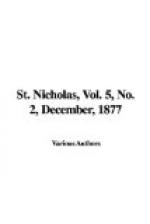DEAR JACK: I was on the St. John’s River at work with my father about three years ago. There were real wild-orange groves there, and the trees bore sour and bitter-sweet fruit. I will now tell you what I was doing on that river. I was pressing out the juice of the sour oranges and boiling it, for making citric acid. We used a cider press for pressing out the juice, and a copper cauldron for boiling it. We shipped the acid to Philadelphia, and I do not know what was done with it next.
These groves were inhabited
by wild beasts, such as opossums, wild
cats, raccoons, deer, and,
occasionally, bears and panthers.
The groves were situated on high mounds, made ages and ages ago, by people of an ancient race known as “mound-builders.” There were always shells on the mounds, which in some instances appeared to be made entirely of shells. Some mounds were fifty feet, or more, above the surrounding country, and from two hundred to four hundred yards in length.
Now, I dare say, you would like me to say of what kind these shells were; but, as I never could find out for myself, I cannot tell you what kind they were. They are unlike any that I have seen elsewhere, and I think they do not belong to any living species of to-day. Farewell, dear Jack!—Yours truly,
TROPIC.
THE BLIND CLERK.
DEAR JACK: Ever so many millions of letters are dropped into the London Post-Office every year, but some are so badly addressed that they never get out again. When a direction is so ill-written that the sorters can’t make it out, the letter is taken to a man they call the “Blind Clerk,” and he generally deciphers it. Why they call him “blind” I don’t know, for few addresses are beyond the power of his sharp eyes to make out. Here is one that did not give him much trouble; but can any of your young folks tell what it means?
Sarvingle
Num for te Quins prade
Lunon.
I’ll send you the “blind” man’s solution next month. Meantime, here is a puzzle for your merry crowd. You shall have an answer in that same postscript; but I should like to have the Little Schoolma’am and the rest work it out for themselves:
“I
am constrained to plant a grove
To
satisfy the girl I love;
And
in this grove I must compose
Just
nineteen trees in nine straight rows,
And
in each row five trees must place,
Or
never more behold her face.
Ye sons of art, lend me your
aid
To please this most exacting maid.”
This puzzle is so old that it probably
will be new to thousands of
your young folks.—Yours truly,
M. B. T.




